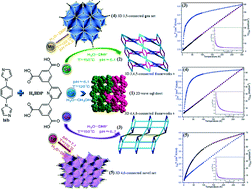Structural diversity of five coordination polymers based on 2,6-bis(3,5-dicarboxyphenyl)pyridine ligand: solvothermal syntheses, structural characterizations, and magnetic properties†
Abstract
Five new coordination polymers (CPs) with distinct structures and topologies, namely, {[Cu(H2BDP)(bib)]0.5·H2O}n (1), {[Co1.5(HBDP)(bib)2(H2O)]·3H2O}n (2), {[Co2(BDP)(bib)2]·H2O}n (3), {[Mn(BDP)0.5(bib)1.5(μ2-H2O)0.5(H2O)]·0.5H2O}n (4), and {[Fe2(BDP)(bib)(H2O)]·H2O}n (5) (H4BDP = 2,6-bis(3,5-dicarboxyphenyl)pyridine, bib = 1,4-bis(imidazol-1-yl)benzene), have been synthesized by systematically tuning the ratios of mixed solvent and pH values. Along with the altering ratios of the mixed-solvent DMF/H2O or CH3OH/H2O used in the synthetic processes, the coordination modes of the ligand change, which further lead to the different structures of resultant complexes. Owing to diverse metal centers and distinct ligand coordination modes, these five complexes exhibit totally diverse structures. Complex 1 displays a 2D 4-connected (44·62)-sql wave-like sheet, which is further expanded to a 3D supramolecular structure via the π⋯π interactions. In complex 2, 1D [Co(bib)]n straight chains and 1D [Co2(bib)3]n ladder-like chains interacted with each other to form a 2D net, which are linked by HBCP3− ligands to generate a 3D (3,4,5)-connected (42·64·73·9)2(62·7)2(64·7·8) architecture. Complex 3 exhibits an unprecedented 3D (4,4,8)-connected net with a Schläfli symbol of (3·42·52·6)4(32·44·54·64·72·86·95·10). Complex 4 exhibits a dinuclear {Mn2(μ2-H2O)} based 3D (4,8)-connected (63)(69·8)-gra framework. For complex 5, the whole structure can be regarded as a {Fe2(COO)4} binuclear SBU-based 3D architecture with (4,6)-connected (44·610·8)(44·62) topology. Besides, the magnetic properties of complexes 3–5 have been investigated.



 Please wait while we load your content...
Please wait while we load your content...